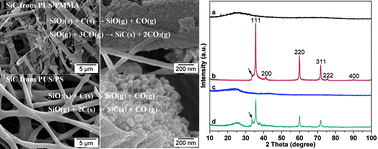Effects of polymer matrices to the formation of silicon carbide (SiC) nanoporous fibers and nanowires under carbothermal reduction†
Abstract
SiC fibers with varied nano-scale morphologies (i.e.,

* Corresponding authors
a
Fiber and Polymer Science, University of California, Davis, California, USA
E-mail:
ylhsieh@ucdavis.edu
Tel: +1 530 752 0843
b Department of Chemical Engineering & Materials Science, University of California, Davis, California, USA
c Ningbo Institute of Material Technology & Engineering, Chinese Academy of Sciences, Ningbo, China
SiC fibers with varied nano-scale morphologies (i.e.,

 Please wait while we load your content...
Something went wrong. Try again?
Please wait while we load your content...
Something went wrong. Try again?
P. Lu, Q. Huang, A. Mukherjee and Y. Hsieh, J. Mater. Chem., 2011, 21, 1005 DOI: 10.1039/C0JM02543G
To request permission to reproduce material from this article, please go to the Copyright Clearance Center request page.
If you are an author contributing to an RSC publication, you do not need to request permission provided correct acknowledgement is given.
If you are the author of this article, you do not need to request permission to reproduce figures and diagrams provided correct acknowledgement is given. If you want to reproduce the whole article in a third-party publication (excluding your thesis/dissertation for which permission is not required) please go to the Copyright Clearance Center request page.
Read more about how to correctly acknowledge RSC content.
 Fetching data from CrossRef.
Fetching data from CrossRef.
This may take some time to load.
Loading related content
